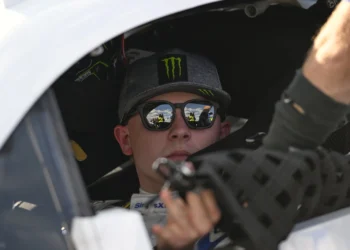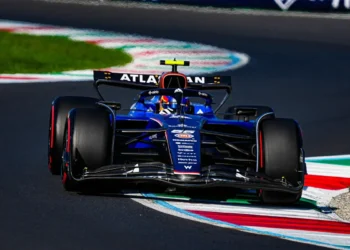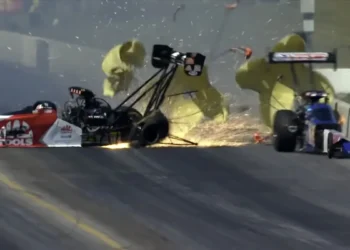Sergio Perez’s dramatic fall from grace at Red Bull has left many wondering: was he doomed from the start, or did Red Bull’s lofty expectations set him up for failure? As his time with the team comes to an end, questions linger about Red Bull’s decision-making and their inability to find a true Verstappen wingman.
Perez’s Red Bull Journey: A Solution Born of Desperation
When Sergio Perez joined Red Bull in 2021, it was a match of necessity. Red Bull’s talent pipeline had faltered, leaving the team scrambling for a capable, experienced driver to support Max Verstappen. Perez, freshly ousted from Racing Point in favor of a declining Sebastian Vettel, was handed a lifeline.
For Red Bull, Perez ticked all the boxes: he was mentally resilient, had a solid reputation in the midfield, brought commercial value, and—crucially—wouldn’t rock the boat alongside Verstappen. He was never meant to be the next Vettel or Verstappen; he was simply a stop-gap, albeit a talented one.
A Promising Start, but Cracks Quickly Showed
Perez’s early Red Bull days had flashes of brilliance but were marred by inconsistency. The 2021 car, built entirely around Verstappen’s unique driving style, was unforgiving to anyone else. Yet Perez still played a pivotal role in Verstappen’s maiden title victory, often sacrificing his own race for the team’s greater good.
The 2022 and 2023 seasons brought Red Bull unprecedented dominance under new regulations. While Verstappen soared to new heights, Perez was a capable deputy, securing points and wins to seal back-to-back Constructors’ Championships. However, troubling patterns emerged:
- In mid-2022, Perez’s performance dipped sharply, with only two podiums in eight races, causing him to fall from 21 points behind Verstappen to over 100 points adrift.
- The 2023 season, despite Red Bull’s overwhelming dominance, saw Perez claim just four podiums in 15 races—a glaring underperformance in a car capable of sweeping the grid.
2024: The Year It All Fell Apart
When Red Bull’s dominance waned in 2024, Perez’s deficiencies became impossible to ignore. While Verstappen carried the team to a fourth consecutive Drivers’ Championship, Perez crumbled under pressure.
His 152 points for the season, compared to Verstappen’s 437, weren’t just underwhelming—they were catastrophic. A mid-season slump turned into a full-blown collapse, with no rebound in sight. Red Bull’s decision to award Perez a contract extension through 2026—despite early signs of decline—now looks like a colossal misjudgment.
Who’s to Blame? Perez or Red Bull?
Perez’s struggles are undeniable, but the bigger question is whether Red Bull bears responsibility for expecting too much from a driver never meant to shoulder such a burden. Marc Priestley, a former McLaren chief mechanic, sees Red Bull’s mismanagement as a key factor:
“Perez was a solution to a specific problem at a specific time. Red Bull thought they could stretch that solution longer than was realistic.”
Perez delivered on Red Bull’s expectations in the beginning. He became a multiple race winner and played a vital role in Verstappen’s championship runs. But as Red Bull’s needs evolved, Perez remained static, exposing a glaring mismatch between team ambitions and driver capability.
Red Bull’s Hubris Comes Home to Roost
Red Bull’s handling of Perez’s tenure reveals a deeper issue: its inability to solve the “second driver” conundrum. In a team built entirely around Verstappen, finding a competitive yet compliant teammate has proven nearly impossible.
The decision to retain Perez through 2024 was defensible given his prior contributions. Extending his contract through 2026, however, was a bold gamble that backfired spectacularly. By doubling down on a driver whose form was already waning, Red Bull effectively delayed addressing a critical weakness in their lineup.
The Future: Is Lawson the Answer?
With Perez out, Liam Lawson steps into the breach—but is he the solution Red Bull needs, or just another stop-gap? Priestley remains skeptical:
“Lawson hasn’t shown the same spark Verstappen or Vettel had when they joined. Red Bull’s second seat remains a double-edged sword.”
While Lawson has impressed in his limited appearances, he now faces the unenviable task of performing under the immense pressure of being Verstappen’s teammate—a role that has ended more careers than it has launched.
Conclusion: A Problem Still Unsolved
Sergio Perez’s Red Bull stint was a calculated risk that worked until it didn’t. His decline in 2024 was inevitable, but the real failure lies with Red Bull’s inability to adapt. By overestimating Perez’s longevity, the team delayed addressing a structural weakness that could haunt them as competition intensifies in 2025 and beyond.
For Perez, the Red Bull chapter is over, but his legacy as a vital contributor to the team’s success remains. For Red Bull, the search for a truly compatible teammate for Verstappen continues—a quest that, if history is any indication, will be anything but straightforward.













